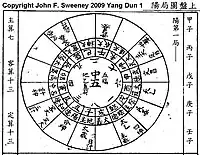| Taiyi shenshu | |||||||
|---|---|---|---|---|---|---|---|
| Traditional Chinese | 太乙神數 | ||||||
| Simplified Chinese | 太乙神数 | ||||||
| |||||||

Taiyishenshu is a form of divination originating in China. It is one of the Three Styles (三式; sānshì; 'three styles') of divination. The others are Da Liu Ren and Qi Men Dun Jia.
Taiyishenshu is used to predict events such as wars or the meaning of supernovae. One form of Taiyishenshu popularized over the centuries predicts personal fortunes. Genghis Khan, founder of the Mongol Empire, referred to Taiyi at one point to decide whether or not his planned invasion of Japan would succeed. When the Taiyi count indicated that invasion would prove unsuccessful, Khan canceled his plans. Numerous examples appear in classical Chinese literature, especially in the dynastic histories.
The methodology is similar to other arts, with a rotating heavenly plate and fixed earthly plate. While the art makes use of the 8 trigrams as well as the 64 hexagrams as a foundation. Analysis is conducted from the Taiyi Cosmic Board and the array of symbols found thereon, with special reference to the position of symbols in specific palaces. Important symbols include the Calculator, the Scholar, Taiyi and Taiyi.
Spirits rotate around the sixteen palaces of the Taiyi cosmic board. 72 cosmic boards apply to the Yin Dun period of each year, and 72 cosmic boards for the Yang Dun period. The spirits land in different palaces with each configuration of the cosmic board. Each board contains "counts" or numbers – the Host Count and the Guest Count taking primary importance over the Fixed Count.
See also
Further reading
- Ho Peng Yoke (2013) [2003]. "The Taiyi System in the Three Cosmic Boards: Method of the Taiyi Deity". Chinese mathematical astrology: reaching out to the stars. Routledge. ISBN 9780415863100.